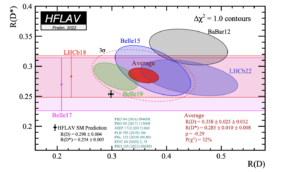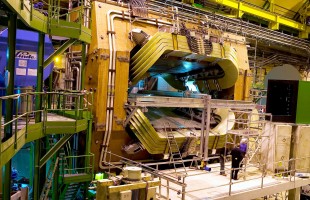The LHCb experiment at CERN has found possible deviations from particle theory that are consistent with what other experiments are seeing. That may be another clue to new unknown particles.
The results of the LHCb test of the so-called lepton universality were announced Tuesday at CERN. That is the principle that standard particle theory sees no fundamental distinction between electrons and their heavier versions: muons and tau particles.

If such a difference does exist, the existing and widely tested Standard Model must be modified or perhaps extended, physicists have been thinking for years. Earlier, for that reason, BarBar in the U.S. and Belle in Japan searched for differences between the three electron-like bodies. They found hints of deviations, but no hard evidence yet.
D-mesons
The LHCb experiment, in which Nikhef is an important partner, mainly looks at the decay of so-called B-mesons that are created when protons from the LHC accelerator collide. B-mesons contain a b-quark that can decay to a c-quark via weak interaction. In the process, so-called D-mesons plus, theoretically, muons or tau particles are created equally often, apart from corrections for their mass.
In the complicated processes involving two different types of D-mesons, LHCb now sees evidence of a deviation from what the standard model predicts. The measurements themselves are statistically more than 3 sigma from the predicted standard value, a hint of a deviation but not yet hard evidence.
Ten years
The combined analyses were worked on for more than seven years. Previously, LHCb had a result for either D meson that could still be statistically consistent with the Standard Model.
The new measurement barely changes the mean and uncertainty of all experiments combined, lead researcher and former Nikhef postdoc Greg Ciezarek said Tuesday at the seminar in Geneva.
“This does not yet change the world, but it is a good reason to continue working on this,” he said. That the different experiments are relatively close together he called important.
In an initial response, Nikhef researcher Suzanne Klaver said from Geneva she is pleased that the analyses are finally complete and so conclusive. She is working on a similar b-decay analysis herself.
Leptoquark
The current results rely on measurements from LHCb in the early years of the LHC accelerator, known as Run1. Meanwhile, there is also a much broader data set from Run2, which is awaiting full analysis, and new measurements are also being made with the newly restarted LHC accelerator.
Theorists have suggested several explanations for any difference between electrons and muons or tau particles. One is a so-called lepto-quark, a particle that interacts with quarks as well as leptons. No such thing exists in the current Standard Model.
